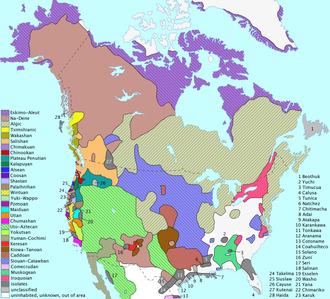- Families
- Arawakan (Maipurean, Maipuran) (~65) – widespread
- Cariban (~40) – Brazil, Venezuela, Colombia, etc.
- Chapacuran (Txapakúran) (9) – Brazil, Bolivia
- Chibchan (23) – Colombia, Venezuela, Panama, Costa Rica
- Jêan (12) – Brazil
- Pano–Takanan (~30) – Brazil, Peru, Bolivia
- Makúan (Makú–Puinavean, Puinavean, Guaviaré–Japurá) (8) – Brazil, Colombia, Venezuela
- Quechuan (23 ?) – Colombia, Ecuador, Peru, Bolivia, Argentina
- Tukanoan (Tucanoan) (~20) – Colombia, Ecuador, Peru, Brazil
- Tupían (~55) – Brazil, Paraguay, Bolivia, etc.
- Arawan (Arahuan, Arauan, Arawán) (6) – Brazil, Peru
- Aymaran (2) – Bolivia, Peru
- Barbacoan (5) – Colombia, Ecuador
- Bororoan (3) – Brazil
- Cahuapanan (2) – Peru
- Cañar–Puruhá (2; uncertain) – Ecuador
- Charruan (3) – Uruguay, Argentina
- Chipaya–Uru (3) – Bolivia
- Chocoan (2–6) – Colombia, Panama
- Cholonan (2) – Peru
- Chonan (Chon) (3) – Argentina
- Guaicuruan (Waykuruan) (5) – Argentina, Paraguay, Brazil
- Guajiboan (4) – Colombia
- Harákmbut–Katukinan (3; uncertain) – Peru, Brazil
- Huarpean (Warpean) (2) – Argentina
- Jabutían (2) – Brazil
- Jirajaran (3) – Venezuela
- Jivaroan (4 ?) – Peru, Ecuador
- Kamakanan (5 ?) – Brazil
- Karajá (2 ?) – Brazil
- Karirian (Karirí) (4) – Brazil
- Krenákan (Botocudoan, Aimoré) (3) – Brazil
- Lule–Vilelan (2) – Argentina
- Mascoyan (4) – Paraguay
- Matacoan (4) – Argentina, Paraguay, Bolivia
- Maxakalían (3) – Brazil
- Mosetenan (2) – Bolivia
- Muran (4, only 1 living) – Brazil
- Nambikwaran (5 ?) – Brazil
- Qawasqaran (Kaweskaran, Alacalufan) (2–3) – Chile
- Otomacoan (2) – Venezuela
- Paezan (1–3; isolate ?) – Colombia
- Purían (2) – Brazil
- Sáliban (Sálivan) (3 ?) – Venezuela, Colombia
- Sechura–Catacaoan (3) – Peru
- Timotean (2) – Venezuela
- Tikuna–Yuri – Peru, Colombia, Brazil
- Tiniguan (2) – Colombia
- Yaguan (3) – Peru
- Witotoan (Huitotoan) (5) – Colombia, Peru
- Yanomaman (4) – Venezuela, Brazil
- Zamucoan (2) – Paraguay, Bolivia
- Zaparoan (3) – Peru, Ecuador
| - Isolates
- Aikaná – Brazil
- Andaquí – Colombia
- Andoque (Andoke) – Colombia, Peru
- Atacameño (Cunza, Kunza, Atacama, Lipe) – Chile, Bolivia, Argentina
- Awaké (Ahuaqué, Uruak) – Venezuela, Brazil
- Baenan – Brazil
- Betoi – Colombia (small family ?)
- Camsá (Sibundoy, Coche) – Colombia
- Candoshi (Candoxi, Maina, Shapra, Murato) – Peru
- Canichana – Bolivia
- Cayuvava (Cayuwaba, Cayubaba) – Bolivia
- Chiquitano – Bolivia
- Chono – Chile
- Cofán (A’ingaé) – Colombia, Ecuador
- Culle – Peru
- Gamela – Brazil
- Guachí – Brazil
- Guató – Brazil
- Irantxe (Iranche, Münkü) – Brazil
- Itonama (Saramo, Machoto) – Bolivia, Brazil
- Jeikó (Jeicó, Jaiko) – Brazil (Macro–Jêan ?)
- Jotí (Yuwana) – Venezuela
- Kaliana (Sapé, Caliana, Cariana, Chirichano) – Venezuela
- Kapixaná (Kanoé) – Brazil
- Koayá (Kwaza, Koaiá, Arara) – Brazil
- Máku (Mako) – Brazil
- Mapudungu (Mapudungun, Araucano, Mapuche, Maputongo) – Chile, Argentina
- Matanauí – Brazil
- Mochica (Yunga, Yunca, Chimú, Mochica, Muchic) – Peru
- Movima – Bolivia
- Munichi (Muniche, Munichino, Otanabe) – Peru
- Natú (Peagaxinan) – Brazil
- Ofayé (Opayé, Ofayé–Xavante) – Brazil (Macro–Jêan ?)
- Omurano (Humurana, Numurana) – Peru
- Otí – Brazil
- Pankararú (Pancararu, Pancarurú, Brancararu) – Brazil
- Payaguá – Paraguay
- Puquina – Bolivia
- Rikbaktsá (Aripaktsá, Eribatsa, Eripatsa, Canoeiro) – Brazil (Macro–Jêan ?)
- Sabela (Huao, Auca, Huaorani, Auishiri) – Ecuador
- Taruma (Taruamá) – Brazil, Guyana
- Taushiro (Pinchi, Pinche) – Peru
- Tequiraca (Tekiraka, Aushiri, Auishiri, Avishiri) – Peru
- Trumai (Trumaí) – Brazil
- Tuxá – Brazil
- Urarina (Simacu, Kachá, Itucale) – Peru
- Wamoé (Huamoé, Huamoi, Uamé, Umã; Araticum, Atikum) – Brazil
- Warao (Guarao, Warau, Guaruno) – Guyana, Suriname, Venezuela
- Xokó – Brazil
- Xukurú – Brazil
- Yagan (Yaghan, Yamana, Yámana) – Chile
- Yaruro (Pumé, Llaruro, Yaruru, Yuapín) – Venezuela
- Yaté (Furniô, Fornió, Carnijó; Iatê) – Brazil
- Yuracaré – Bolivia
- Yurumangui – Colombia
|





